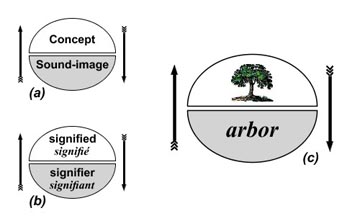Like language, narrative refers to concept rather than reality. The structuralist description of the sign can be extended to narrative, since both words and stories are symbols played out across time. A word occurs as a sequence, as when we say or read “T – U – N – D – R – A.” Similarly, a narrative may be defined as signs in a series. The story then can be considered a sign itself, an arbitrary signifier, referring not to events in the real world, but to a subjective concept of what happened, is happening and will happen.

(Diagrams of the plot from Laurence Stern’s Tristram Shandy)
 At the beginning of the last century, Ferdinand de Saussure severed language from reality. In his Course in General Linguistics, he explained that a sign is made up of two parts: the signifier and the signified. The signifier is a word, a set of sounds, sometimes represented by letters. The signified is what the signifier arbitrarily refers to. Unfortunately for those who want language to be a transparent window on the world, the signified is not an external object, but a subjective concept.
At the beginning of the last century, Ferdinand de Saussure severed language from reality. In his Course in General Linguistics, he explained that a sign is made up of two parts: the signifier and the signified. The signifier is a word, a set of sounds, sometimes represented by letters. The signified is what the signifier arbitrarily refers to. Unfortunately for those who want language to be a transparent window on the world, the signified is not an external object, but a subjective concept.